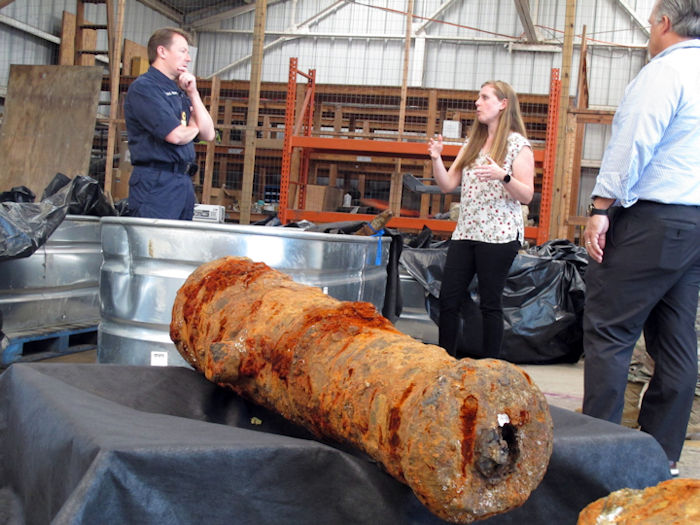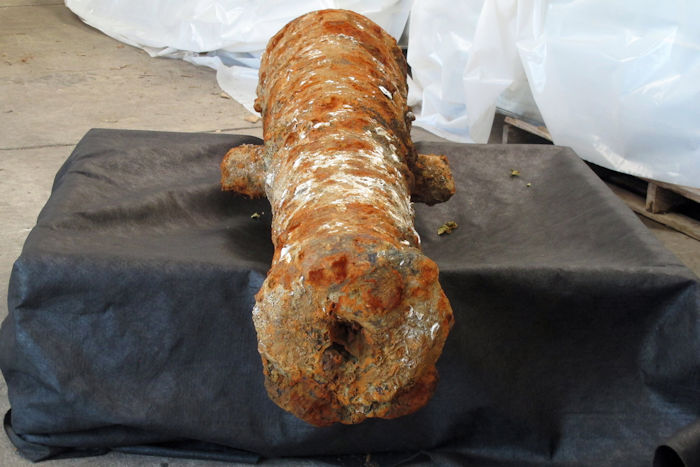Jan Bartek – AncientPages.com – A historical treasure consisting of 19 cannons suspected to have been sH๏τ from British ships during the American Revolution is now being investigated by archaeologists. Still, in excellent condition, the cannons that have been lost for 240 years were discovered by accident in the Savannah River.
“A dredge scooping sediment from the riverbed last year as part of a $973 million deepening of Savannah’s busy shipping channel surfaced with one of the cannons clasped in its metal jaws. The crew soon dug up two more,” the ᴀssociated Press reports.

Commodore Philip Nash, left, of the British Royal Navy, gets a briefing from U.S. Army Corps of Engineers archaeologist Andrea Farmer on Thursday, April 28, 2022, in Savannah, Ga., about 19 cannons recovered from the Savannah River, that experts suspect came from one or more British ships scuttled in the river during the American Revolution in 1779. Credit: AP PH๏τo/Russ Bynum
Archaeologists guessed the mud- and rust-encrusted guns were most likely leftover relics from a sunken Confederate gunship excavated a few years earlier in the same area, Andrea Farmer, an archaeologist for the Army Corps of Engineers said. However, when the U.S. Navy investigated the guns the experts found they didn’t match any known cannons used in the Civil War. Further research indicates they’re likely almost a century older and sank during the buildup to the Revolutionary War’s bloody siege of Savannah in 1779.
In a timeframe of just over a year, 19 cannons were hoisted from the same area of the river a few miles downstream from Savannah, where Georgia was founded as the last of Britain’s 13 American colonies in 1733.
“They’re in remarkably good shape,” Farmer said. “Many were buried in clay and covered by silt and debris that kind of protected them.
Now officials with the U.S. and British governments, as well as the state of Georgia, are working together on an agreement to preserve the newly found guns before putting them on display. Commodore Philip Nash of the British Royal Navy, a military attache based in Washington, viewed the artifacts submerged in metal tubs of water during a visit Thursday.
“Some of these pieces are in amazing condition and I’m sure could tell some stories,” Nash said.
At present, the cannons are being kept underwater to prevent further deterioration until experts can carefully clean them. Meanwhile, researchers are looking for more definitive proof linking the cannons to British ships from the American Revolution.
According to Farmer, “researchers are very confident of the connection. Savannah had been under British occupation for about a year by the fall of 1779, when colonists planned an attack to retake the city with help from French and Haitian allies.
When French ships carrying troops were spotted off the Georgia coast, the British hurried to scuttle at least six ships in the Savannah River downstream from the city to block the French vessels. The land battle that followed was one of the bloodiest of the war. British forces killed nearly 300 colonial fighters and their allies, while wounding hundreds more.
Farmer said researchers suspect the cannons found in the river came from the British ship HMS Savannah and possibly a second ship scuttled at the same time, the HMS Venus. The longer guns appear to match cannons manufactured in France during the mid-1700s, she said. Researchers are looking for ship logs and manifests in hopes of confirming the armaments aboard those ships.

A cannon encrusted in rust and mud sits inside a warehouse operated by the Army Corps of Engineers in Savannah, Ga., on Thursday, April 28, 2022. It’s one of 19 cannons discovered in the Savannah River since last year that experts believe date to the American Revolution, when British ships were scuttled in the river to block colonists’ allies from reaching Savannah by ship.Credit: AP PH๏τo/Russ Bynum
It’s also possible the cannons themselves and other artifacts found at the site—pieces of anchors and a portion of a ship’s bell—once cleaned might bear markings or other clues to which ship they belonged to. The wood from those ships, Farmer said, decayed long ago or got destroyed by prior dredging projects over a series of decades.”
The tricky question that still has no answer is – who owns the cannons now?
The guns were found in state waters of Georgia during a dredging project headed by the Army Corps, a U.S. government agency. The British government could make an ownership claim if there’s strong evidence the artifacts came from British ships.
See also: More Archaeology News
Farmer said all of those parties are working on an agreement to preserve the cannons and ultimately have them displayed at the Savannah History Museum, which incorporates the battlefield where the bloodiest fighting occurred during the 1779 siege.
“Everybody wants to keep the artifacts in Savannah,” Farmer said, “because that makes the most sense.”
Written by Jan Bartek – AncientPages.com Staff Writer





